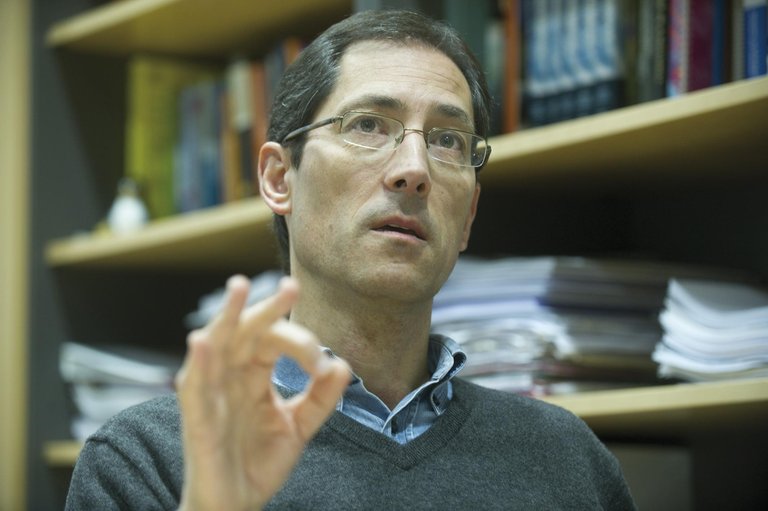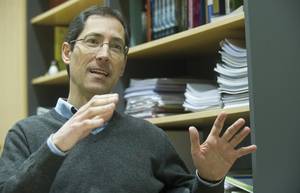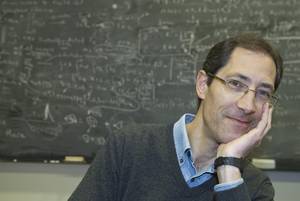"We have to continue to do so until now, but adapting ourselves to the needs that demand and offer the situation"

Thank you! The truth is that my main vocation and activity has always been scientific research. That is, I am a scientist. But also Basque, and in that sense, I have always made an effort to combine the internationalization of science with the promotion of Basque. And this is consistent with Elhuyar’s mission of “We work to strengthen Basque in science, technology and society, and build new fields for it, with the aim of an active and critical Basque community.”
On the other hand, in recent years I have also had a relationship with Elhuyar, and I sincerely believe that it is a pioneering project, with strong roots and without losing the north. In that project I believed and believe, so when they offered me to take the presidency I had no choice but to accept it and I enjoyed it.
Yes, it has not been a very close relationship, but I have written several articles for Elhuyar magazine, yes, also for the initial Elhuyar. In recent years I have participated in the Encyclopedic Dictionary of Science and Technology Elhuyar, in Teknopolis and in Norteko Ferrokarrilla, I have been a member of the jury of the CAF-Elhuyar... I have known the project closely.
Elhuyar's work in these 40 years has been enormous and has put the necessary supports to combine the specialized communication of science with the Basque language. He has made a great contribution to the development of the Basque language, being an example in Euskal Herria, and can be an example for other languages outside the Basque Country.
That's what we've done so far. Now things have changed: society has totally changed, the situation of the Basque language has also changed... The time has come to reflect and, fortunately, Elhuyar has made his reflection and we begin a new stage.
Anyway, the beginning of the new era does not mean that we have to do different things. It means that we have to continue doing what we have done so far, but adapting ourselves to the needs that demand and offers the new situation. And we will also do new things. Thus, Elhuyar has reorganized, now we have a group in which we have four units [science, language and technology, advice and communication] to continue working, adapted to current needs.
Because it is part of the normalization of the Basque language. Now I'll tell you a little more, but that's the brief answer. For the Basque language to be normalized and alive, it is essential that there be specialized communication in Basque in all fields.
It is a very common question and it is appropriate to reflect on it. How to publish research papers? In English, in international specialized magazines, as in all countries. In English also in international congresses and in English with international comrades.
But among the Basques, although we have specialized topics, we must be able to discuss in Basque. For this purpose, supports are needed. If not, we should use English or another language to discuss specialized topics among Basques. Therefore, we need supports that are achieved when we ever express something in Basque.
At first we published articles specialized in Basque in the magazine Elhuyar. I have an article specialized in the magazine Elhuyar of the time, in Basque. But today there is no such magazine and I don't think we have to have it. On the contrary, the writing of the theses in Basque is very adequate, since it reflects on it and this contributes to the normalization of communication specialized in Basque. Because what is written is a reference. If we write directly in Basque, without translating, better.
For the Basque language to be intense it is necessary. And why not create new science in Basque? Science is not only produced in English, but can also be created in other languages, even in Basque. The main language of NanoGUNE is English, both oral and written. We have researchers from 22 different countries. But among the Basques we speak in Basque, with total normality, even when we study specialized topics. In this measure, Elhuyar has contributed to the normalization of the Basque language. In addition, then comes the scientific dissemination, is the entire chain.
My main responsibility is to direct experimental research teams. But I also do research. I am a theoretical researcher and has always been interested in the behavior of the electrons of matter. It is a very complex problem: there are many electrons and, in physics, the only problem that can be exact is that of the two bodies; if three bodies are placed, this cannot be released. In the matter we have several electrons, and there arise interesting things.
Thus, my area has always been the dynamics of the electrons of matter. It can be in solids, surfaces or nanostructures. I started studying the microscope of tunnels that emerged in the 1980s. This was, to some extent, one of the bases of nanotechnology, since it was then possible to see atoms one by one. And then also manipulate: catch an atom and place it in another place. This was allowed by the microscope of tunnels, and at that time I began to study it.
Yes, but then the word nanotechnology was not used. From there I went towards nanoscience, and I don't know what I'm going to do tomorrow, but yesterday yes, at this time I'm studying the electronic excitations of graphene. That is, how the electrons of graphene are excited before the external effects. Electronic excitation, when it is collective, is given name to plasmons; we have found a new plasmon. Here is the new project! [has taken a paper game on the table].
We have found a new plasmon, that is, a new collective electronic excitation, which we will soon send to the best physics magazine, Physical Review Letters.
Yes, yes. Now I'm rounding the article, and to remove the uf..., it will tend a lot. The truth is that we have made an announcement that we will publish through this article.
Acoustic plasmons in extrinsic free-standing graphene. As we have said, it is an ad, but we, here in nanoGUNE, have the ability to measure this kind of thing. Other things have been measured in graphene, but not what we are looking for. However, as we have experimental tools to measure it, the next step would be to measure it. And the next, know what to do with it.
For the moment it serves to satisfy our curiosity. For now, for this.
Buletina
Bidali zure helbide elektronikoa eta jaso asteroko buletina zure sarrera-ontzian













